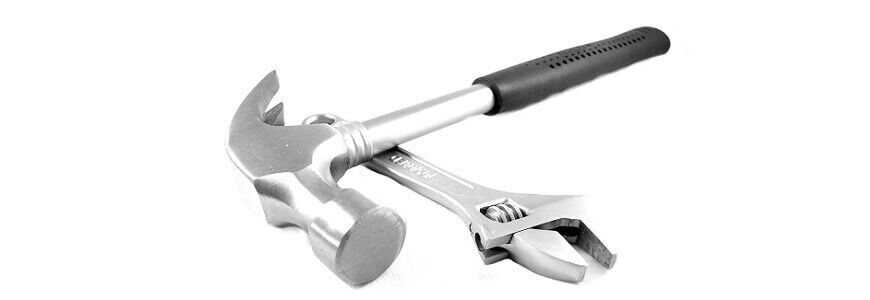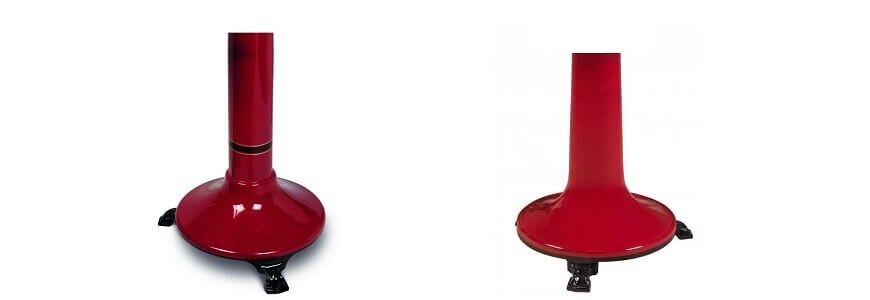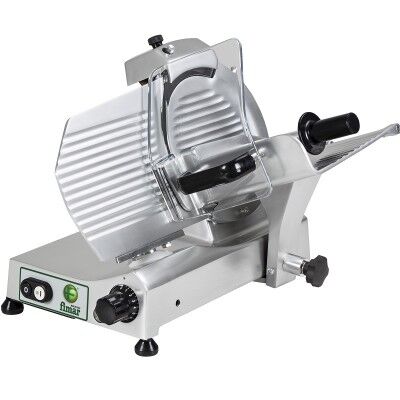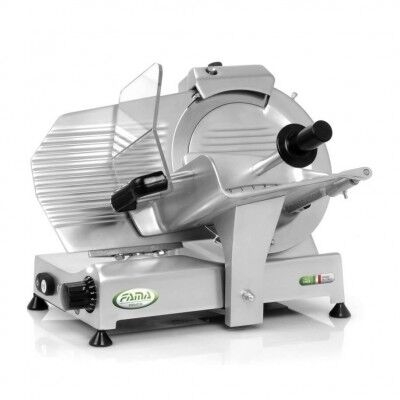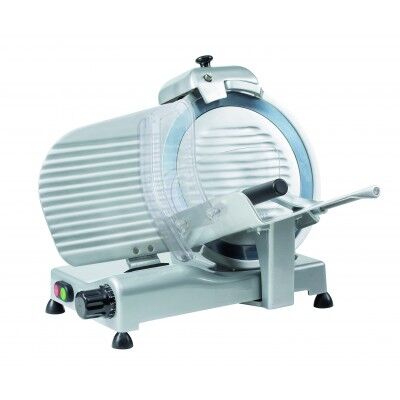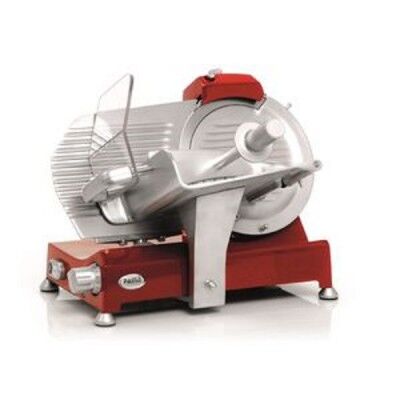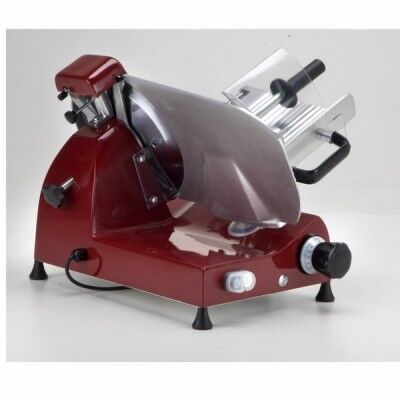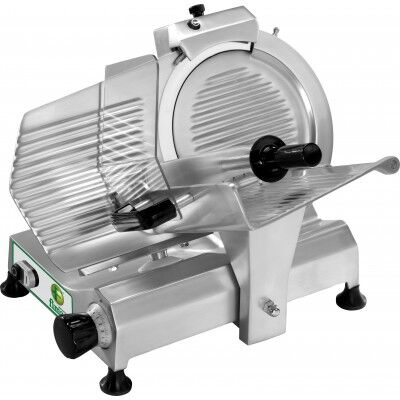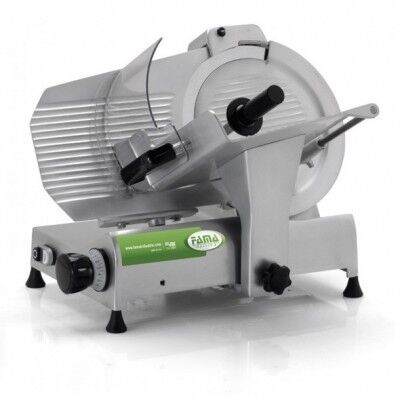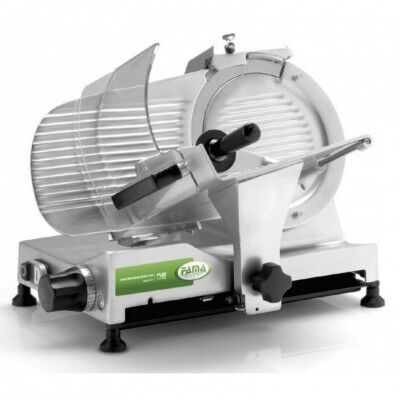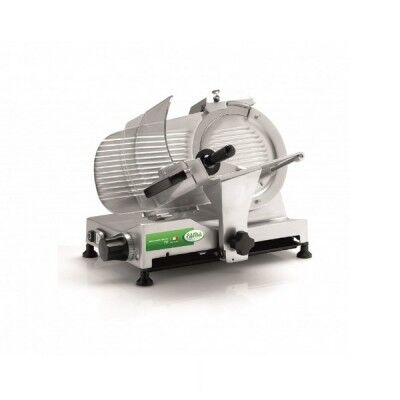Slicers and Meat Slicers
In this section, we focus on the vast world of professional slicers and meat slicers. Below, we present products made exclusively with a monocoque frame, ensuring the highest cutting quality. Additionally, each machine is equipped with a blade sharpener and certified with a professional CE certification.
You can choose from various types of slicers: gravity slicers, vertical slicers, or flywheel slicers. Each offers unique features to meet the needs of multiple businesses, such as butcher shops, food stores, restaurants, bars, and more. If you're looking for a professional slicer, you've come to the right place. If you have any doubts, don’t hesitate to contact us.
Professional Slicer
Navigating the vast world of professional slicers can be tricky, given the wide variety of models available on the market.
Professional slicers differ from domestic ones in the type and quality of materials and components used in their construction.
First and foremost, the materials they are made of: the frame, carriage, plate, and meat press arm are typically constructed from aluminum or specific anodized alloys.
Additionally, the motors installed in professional versions are more powerful and ventilated to ensure continuous operation over time without performance loss due to overheating.
The blades of professional slicers are concave and forged, and they can easily reach diameters of 35 or 37 cm.
Let’s simplify things a bit.
The main categories of slicers are:
- Gravity slicers
- Vertical slicers
- Flywheel slicers
- Meat slicers
Slicers
Professional Gravity Slicers
Professional gravity slicers are a cost-effective option for businesses that need a simple machine capable of primarily slicing cured meats and cheeses.
Thanks to the inclined carriage toward the blade, the product naturally slides (due to gravity) toward the blade, making cutting operations simpler and more practical.
Professional Vertical Slicers
Professional vertical slicers are machines designed primarily for food stores, delis, or butcher shops, capable of delivering high-level performance.
In this type of machine, the weight of the product is fully supported by the slicer’s carriage, resulting in precise cuts and reduced blade wear. This type of professional slicer is particularly suitable for cutting large cured meats and meat chunks. Typically, these machines come in medium to large sizes, with blades ranging from 30 cm to 37 cm in diameter.
Flywheel Slicers
Flywheel slicers are manual versions that offer the same functions as electrified ones but usually come with a distinct vintage aesthetic appeal. Additionally, these slicers ensure precise cutting without heating the product.
The slice thickness can be adjusted via the knob, ranging from a few millimeters (e.g., for thin slices of prosciutto) to one or two centimeters (e.g., for meat cuts).
Cleaning the Slicer
At the end of the day, it’s necessary to remove food residues from the slicer to prevent buildup and, most importantly, bacterial proliferation. It’s worth noting that food scraps from various cuts tend to accumulate more frequently in hard-to-reach areas like the blade guard, the meat press, and other internal zones. So, how can you clean the slicer effectively?
First and foremost, unplug the machine to avoid accidental activation during cleaning.
Next, it’s advisable to set the slice thickness adjustment knob to zero to prevent accidentally bumping into the blade during cleaning.
Now, using a damp cloth, wipe down the moving surfaces to remove any residues that have accumulated. Repeat the same process on the opposite side of the cutting area.
At this point, you can remove the blade guard by loosening the specific screws for manual removal. The blade guard prevents slices from getting caught in the blade’s rotation space. Remove the guard, clean it thoroughly, and reposition it.
Blade Sharpening
Over time, you may notice that the slicer requires more pressure against the blade to cut, forcing you to increase the slice thickness to achieve a good cut. This indicates that it’s time to sharpen the blade of your professional slicer.
Here’s how to do it:
A respectable professional slicer typically comes with a built-in sharpener, consisting of two small circular grinding stones.
The sharpener is positioned above the blade in a way that does not interfere with normal operation.
To use it, rotate the sharpener block 180° and secure it with the designated locking knob. Then, simply press the two buttons that bring the stones closer to the blade to start the sharpening process.
Prices of Professional Slicers
The prices of professional slicers vary based on technical specifications, blade size, and features offered. When considering the purchase of a professional slicer, it’s important to carefully evaluate the features that best meet the user’s specific needs. The price of professional slicers can depend on the quality of materials used in construction, motor power, blade precision, or the effective cutting capacity the slicer offers. Therefore, it’s advisable to compare different models, taking into account all the characteristics mentioned above in relation to cost, to make an informed investment and get the best value for money based on your needs.
FAQ - Frequently Asked Questions
Here are the main questions to consider when choosing a professional slicer:
Which slicer should I choose based on the product I need to slice?
- Professional gravity slicers are a cost-effective option for businesses needing a simple machine primarily for slicing cured meats and cheeses.
- Vertical slicers are designed for food stores, delis, or butcher shops and offer high-level performance.
- Flywheel slicers are manual versions that ensure precise cutting without heating the product and provide a typically vintage aesthetic appeal.
What is the effective cutting capacity I can expect from the machine?
Slicers equipped with the same blade diameter can offer significantly different effective cutting lengths, known as the "cutting capacity." This is because the cutting length also depends on the carriage travel (or stroke), not just the blade size.
What is the maximum footprint of the machine?
It’s important to consider the overall dimensions of a slicer, as people often overlook that the food carriage typically requires additional space beyond the machine’s frame when in operation. For this reason, it’s crucial to account for this when planning the space where the slicer will be placed.
How much do professional slicers cost?
Professional slicers for food stores, delis, and butcher shops, including gravity, vertical, and premium flywheel models, are available in this category starting from €241.00 + VAT!
What are the best brands of professional slicers?
Among the most well-known brands for professional use in the Italian market are Berkel, Fimar, Fama Industrie, Celme, and a few others.
Professional slicers on offer
In this category, you’ll find dozens of professional slicers on offer, selected from the best Italian manufacturers. Machines of all sizes to meet a wide range of needs at the best market prices. Our catalog includes over 50 models starting from €241.00 + VAT.
Compare the numerous products available for immediate delivery and choose the offer that best suits your needs!

